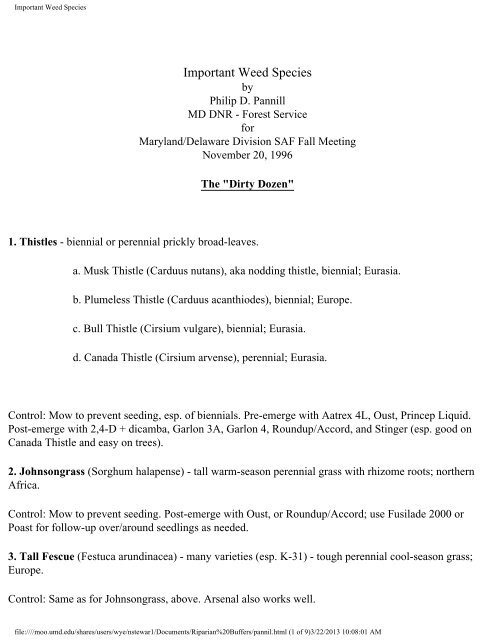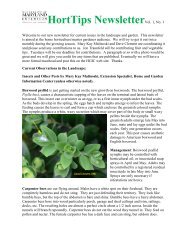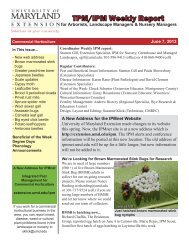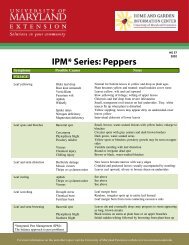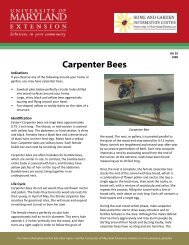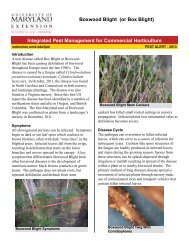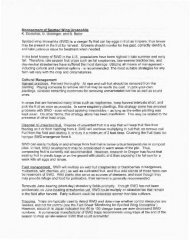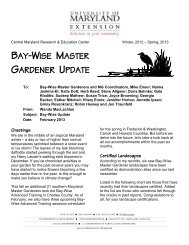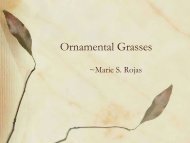Important Weed Species - University of Maryland Extension
Important Weed Species - University of Maryland Extension
Important Weed Species - University of Maryland Extension
Create successful ePaper yourself
Turn your PDF publications into a flip-book with our unique Google optimized e-Paper software.
<strong>Important</strong> <strong>Weed</strong> <strong>Species</strong><br />
<strong>Important</strong> <strong>Weed</strong> <strong>Species</strong><br />
by<br />
Philip D. Pannill<br />
MD DNR - Forest Service<br />
for<br />
<strong>Maryland</strong>/Delaware Division SAF Fall Meeting<br />
November 20, 1996<br />
The "Dirty Dozen"<br />
1. Thistles - biennial or perennial prickly broad-leaves.<br />
a. Musk Thistle (Carduus nutans), aka nodding thistle, biennial; Eurasia.<br />
b. Plumeless Thistle (Carduus acanthiodes), biennial; Europe.<br />
c. Bull Thistle (Cirsium vulgare), biennial; Eurasia.<br />
d. Canada Thistle (Cirsium arvense), perennial; Eurasia.<br />
Control: Mow to prevent seeding, esp. <strong>of</strong> biennials. Pre-emerge with Aatrex 4L, Oust, Princep Liquid.<br />
Post-emerge with 2,4-D + dicamba, Garlon 3A, Garlon 4, Roundup/Accord, and Stinger (esp. good on<br />
Canada Thistle and easy on trees).<br />
2. Johnsongrass (Sorghum halapense) - tall warm-season perennial grass with rhizome roots; northern<br />
Africa.<br />
Control: Mow to prevent seeding. Post-emerge with Oust, or Roundup/Accord; use Fusilade 2000 or<br />
Poast for follow-up over/around seedlings as needed.<br />
3. Tall Fescue (Festuca arundinacea) - many varieties (esp. K-31) - tough perennial cool-season grass;<br />
Europe.<br />
Control: Same as for Johnsongrass, above. Arsenal also works well.<br />
file:////moo.umd.edu/shares/users/wye/nstewar1/Documents/Riparian%20Buffers/pannil.html (1 <strong>of</strong> 9)3/22/2013 10:08:01 AM
<strong>Important</strong> <strong>Weed</strong> <strong>Species</strong><br />
4. Mile-a-minute (Polygonum perfoliatum), aka devil's tearthumb, devil's-tail tearthumb - fastgrowing<br />
prickly annual vine; eastern Asia.<br />
Control: Mowing, cutting, or pulling before seed development. Pre-emerge with Aatrex 4L, Arsenal AC,<br />
Oust, Princep Liquid, Velpar L. Post-emerge with Arsenal AC, Crossbow, Garlon 3A, Garlon 4,<br />
Roundup/Accord. Use <strong>of</strong> a surfactant is essential.<br />
5. Climbing Buckwheats - smooth twining annual vines.<br />
a. Wild Buckwheat (Polygonum convolvulvus), aka black bindweed, climbing bindweed,<br />
cornbind; Europe.<br />
b. Climbing False Buckwheat (Polygonum scandens), aka hedge bindweed, hedge<br />
buckwheat; native.<br />
Control: Same as for mile-a-minute, above. Also post-emerge with Stinger.<br />
6. Japanese Knotweed (Polygonum cuspidatum), aka Mexican-bamboo, Japanese-bamboo (misnomers)<br />
-clumping cane-like perennial with spreading roots; Japan.<br />
Control: Mowing or digging is usually ineffective, even if repeated. Post-emerge with Arsenal AC (once<br />
or twice); Garlon 3A, Garlon 4, or 2,4-D + dicamba (at least twice); Roundup/Accord (at least three<br />
times). Velpar or Escort/Ally may be worth trying .<br />
7. Kudzu (Pueria lobata) - fast-growing perennial vine; eastern Asia..<br />
Control: Post-emergent with Arsenal AC (once or twice); Garlon 3A, Garlon 4, or 2,4-D + dicamba (at<br />
least twice); Roundup/Accord (at least three times).<br />
8. Japanese Honeysuckle (Lonicera japonica) - smooth twining woody vine with persistent leaves;<br />
Japan.<br />
Control: Often necessary to manually cut vines, wait until regrowth begins, then use directed spray.<br />
Postemerge with 2,4-D, 2,4-D + dicamba, Arsenal AC, Crossbow, Garlon 3A, Garlon 4, Roundup/<br />
Accord. Follow-up spray is <strong>of</strong>ten needed.<br />
9. Oriental Bittersweet (Celastrus orbiculatus), aka Asiatic bittersweet - smooth, twining, highclimbing<br />
woody vine with brightly colored fruit; eastern Asia. Similar to American bittersweet (Celastrus<br />
scandens).<br />
Control: Same as for Japanese honeysuckle, above.<br />
file:////moo.umd.edu/shares/users/wye/nstewar1/Documents/Riparian%20Buffers/pannil.html (2 <strong>of</strong> 9)3/22/2013 10:08:01 AM
<strong>Important</strong> <strong>Weed</strong> <strong>Species</strong><br />
10. Bush Honeysuckles - woody shrubs with bright red berries.<br />
a. Amur Honeysuckle (Lonicera maakii); eastern Asia.<br />
b. Tartarian Honeysuckle (Lonicera tartarica); eastern Asia.<br />
Control: Post-emerge with 2,4-D + dicamba, Arsenal AC, Crossbow, Escort/Ally, Garlon 3A, Garlon 4,<br />
Roundup/Accord. Thorough coverage <strong>of</strong> plant is important.<br />
11. Multiflora Rose (Rosa multiflora) - thorny woody shrub; eastern Asia.<br />
Control: Same as for Bush Honeysuckles, above. Escort or Ally are esp. effective.<br />
12. Tree-<strong>of</strong>-Heaven (Ailanthus altissima), aka ailanthus, shumac, stink-tree - large tree with suckering<br />
roots; China.<br />
Control: Manual & mechanical treatments yield poor results unless begun in early summer and repeated<br />
frequently for several years, or unless heavy shade is present. Post-emerge foliar spray as for Bush<br />
Honeysuckle, above. Basal bark spray trees under 4" dbh with Chopper RTU or Garlon 4 in March,<br />
June, or July. Use cut surface treatments (stump, girdle, frill, injection) with Banvel, Chopper RTU,<br />
Garlon 3A, Tordon RTU/Pathway, June 15 - September 1; or Banvel or Vanquish, J une 15 - Nov. 1.<br />
May use Banvel, Tordon RTU/Pathway, or Vanquish for cut surface treatment at other times, but be<br />
prepared to spray root suckers next growing season.<br />
AGRICULTURE ARTICLE<br />
ANNOTATED CODE OF MARYLAND<br />
Title 9<br />
Subtitle 4. <strong>Weed</strong> Control<br />
9-401 (a) The existence <strong>of</strong> growth <strong>of</strong> certain species <strong>of</strong> plants is declared to be noxious.<br />
(b) The following plants are considered to be noxious weeds in the State:<br />
(1) Thistles belonging to the Asteraceae or compositae family, including Canada,<br />
Musk, Nodding, Plumeless, and Bull Thistle;<br />
(2) Johnsongrass (Sorghum Halepense) or hybrids that contain Johnsongrass as a parent;<br />
and<br />
file:////moo.umd.edu/shares/users/wye/nstewar1/Documents/Riparian%20Buffers/pannil.html (3 <strong>of</strong> 9)3/22/2013 10:08:01 AM
<strong>Important</strong> <strong>Weed</strong> <strong>Species</strong><br />
(3) Shatter Cane and Wild Cane (Sorghum Bicolor).<br />
9-402 The Secretary may:<br />
(1) Make investigations, studies, and determinations he deems advisable in order to<br />
ascertain the extent <strong>of</strong> growth and infestation <strong>of</strong> a noxious weed, other weed species in the<br />
State, and the effect <strong>of</strong> the species on agricultural production;<br />
(2) Following public hearing, designate as noxious weeds other species <strong>of</strong> plants which<br />
adversely affect or threaten agricultural production, and carry out practices necessary to<br />
bring about control or abatement <strong>of</strong> the species, or both;<br />
(3) Institute programs <strong>of</strong> control and eradication;<br />
9-404 (a) No person may:<br />
(4) Enter into agreements with any county and subdivision <strong>of</strong> the State, with any adjoining<br />
state, and with agencies <strong>of</strong> the federal government to effect a program <strong>of</strong> control and<br />
eradication;<br />
(5) Accept, use, or expend any aid, gift, grant, or loan made available from any private or<br />
public source to carry out the provisions <strong>of</strong> this subtitle; and<br />
(6) Following a public hearing declare a quarantine to control or eradicate any exotic<br />
plant, which means a plant species not previously known to occur in the state or known to<br />
be <strong>of</strong> only limited distribution in the state, as determined by the Secretary.<br />
9-403 After an agreement between the Secretary and the county is executed, the Secretary<br />
and the county may conduct surveys to determine the location and amount <strong>of</strong> infestation<br />
<strong>of</strong> a noxious weed or other plant species within the county. Both parties may provide<br />
technical assistance to landowners in a cooperative control or eradication program, and<br />
may effect a program <strong>of</strong> mowing, spraying, or other control or eradication practices on<br />
any road right-<strong>of</strong>-way, drainage ditch bank, park, playground, and any other public or<br />
private land. The agreement between the Secretary and county may be terminated by<br />
either party on 30 days written notice.<br />
(1) Import or transport a noxious weed in the state in any form capable <strong>of</strong><br />
growth; or<br />
(2) Contaminate any uninfested land with a noxious weed through the<br />
movement <strong>of</strong> rootstocks, seed, soil, mulch, nursery stock, farm machinery,<br />
or any other artificial medium.<br />
file:////moo.umd.edu/shares/users/wye/nstewar1/Documents/Riparian%20Buffers/pannil.html (4 <strong>of</strong> 9)3/22/2013 10:08:01 AM
<strong>Important</strong> <strong>Weed</strong> <strong>Species</strong><br />
(b) Each landowner, including a landowner <strong>of</strong> public land, or person who possesses and<br />
manages land infested with a noxious weed shall eradicate or control the noxious weed on<br />
that land by using practices that the Secretary prescribes, including mowing , cultivating,<br />
or treating with an approved herbicide.<br />
9-405 Each failure to comply with the provisions <strong>of</strong> this subtitle shall be reported to the<br />
State's Attorney for the county in which the violation occurs. The State's Attorney shall<br />
prosecute all violations and bring an action to enjoin any nuisance. However, a landowner<br />
or other person who possesses and manages the land may enter into a written agreement<br />
with the Secretary which sets forth a program for the eradication or control <strong>of</strong> a noxious<br />
weed, and if all the terms and conditions <strong>of</strong> the agreement are met, there is no violation <strong>of</strong><br />
this subtitle as to the land covered by the agreement.<br />
TITLE 12<br />
PENALTIES AND FINES<br />
Subtitle 1. Penalties and Fines<br />
12-101 Penalty for first <strong>of</strong>fense.<br />
Any person who violates any provision <strong>of</strong> this article is guilty <strong>of</strong> a misdemeanor. Unless<br />
another penalty specifically is provided elsewhere in this article, the person, upon<br />
conviction, is subject to a fine not exceeding $500, or imprisonment not excee ding three<br />
months, or both, with costs imposed in the discretion <strong>of</strong> the court.<br />
12-102 Penalty for second or subsequent <strong>of</strong>fense.<br />
1987<br />
Unless another penalty specifically is provided elsewhere in this article, any person found<br />
guilty <strong>of</strong> a second or subsequent violation <strong>of</strong> any provision <strong>of</strong> the same title, is subject to a<br />
fine not exceeding $1,000, or imprisonment not exceeding one year , or both, with costs<br />
imposes in the discretion <strong>of</strong> the court. For the purposes <strong>of</strong> this section, a second or<br />
subsequent violation is one which has occurred within two years <strong>of</strong> any prior violation <strong>of</strong><br />
this title and which arises out <strong>of</strong> a separate set <strong>of</strong> c ircumstances.<br />
<strong>Maryland</strong> Dept. <strong>of</strong> Natural Resources<br />
Forest Service<br />
file:////moo.umd.edu/shares/users/wye/nstewar1/Documents/Riparian%20Buffers/pannil.html (5 <strong>of</strong> 9)3/22/2013 10:08:01 AM
<strong>Important</strong> <strong>Weed</strong> <strong>Species</strong><br />
FORESTRY INFORMATION BULLETIN<br />
MILE-A-MINUTE CONTROL<br />
Mile-a-minute (Polygonum perfoliatum), also known as tear-thumb, is a fast-growing annual vine which<br />
has become a problem in some parts <strong>of</strong> <strong>Maryland</strong>, and is expected to increase. It is originally from Japan<br />
and eastern Asia . It was accidentally introduced into southeastern Pennsylvania sometime prior to 1946,<br />
probably in a shipment <strong>of</strong> holly seed from the far east (Moul, 1948). It has since spread through eastern<br />
and central Pennsylvania, central and western <strong>Maryland</strong>, and in to West Virginia. This weed has the<br />
potential to be a serious problem in forest areas where openings in the canopy exist due to insect or<br />
disease activity, storm damage, or harvesting; and along field edges, roadsides, utility right-<strong>of</strong>-ways, and<br />
streambanks, and in Christmas tree plantings.<br />
Identification<br />
Mile-a-minute is fairly easy to distinguish from other plants. It is a long, weak spindly vine with a<br />
multitude <strong>of</strong> short, sharp, curving prickles. The prickles make the plant very hard to handle. It has pale<br />
green triangular leaves 1-3 inches across. There are round leaf-like sheaths at branch nodes along the<br />
length <strong>of</strong> the stem. The leaves and vines sometimes turn reddish as they mature. Over the winter the<br />
dead vines appear as mats <strong>of</strong> brittle brown vines. The plant has small shallow roots, and is easily<br />
uprooted. The clusters <strong>of</strong> small berrylike fruit are green in summer, turning pale blue in late summer and<br />
fall. Each fruit has one round blue-black seed about 1/8th inch in diameter. There are other tear-th umbs<br />
which are native to Maryl and, but only mile-a-minute has leaves which are nearly perfect triangles, and<br />
is the only one which has fleshy fruits (Riefner and Windler 1979).<br />
file:////moo.umd.edu/shares/users/wye/nstewar1/Documents/Riparian%20Buffers/pannil.html (6 <strong>of</strong> 9)3/22/2013 10:08:01 AM
<strong>Important</strong> <strong>Weed</strong> <strong>Species</strong><br />
Life Cycle<br />
Seeds <strong>of</strong> mile-a-minute usually germinate and begin to grow in late March and early April, although<br />
some seed will germinate later. The preferred conditions for growth are in nearly full sunlight, in areas<br />
where there is plenty <strong>of</strong> av ailable moisture, or plenty <strong>of</strong> organic matter to mulch the soil. The young<br />
vines grow rapidly through the spring and summer. They can grow up to 6 inches a day, and up to 25<br />
feet in length by the end <strong>of</strong> the summer. They are not strong climbers, but will g row over small trees<br />
and shrubs, and over fallen trees, fences, woodpiles, etc.<br />
The plant starts to produce green fruit late in June, which then ripen in late summer and early fall. It is<br />
important to control the vines before the first seeds ripen to maturity, usually in late July. The plants<br />
themselves do not live through the winter, and are usually killed by the first hard frost. The pale blue<br />
fruit, each containing one seed, are held on the vine. These eventually drop <strong>of</strong>f and regenerate the plant<br />
on site, or are moved to other locations by birds, rodents, machin ery, and flood waters.<br />
Manual Control<br />
Mile-a-minute is very shallow rooted and can easily be pulled out, especially in spring and early summer<br />
before the vines become long and tangled. Wear long sleeves, long pants, and gloves. A garden rake can<br />
help uproot tangled vine s. Manual control should be completed before seeds begin to ripen. Recheck the<br />
site periodically to remove any plants which were missed or which re-sprouted. This is an excellent way<br />
<strong>of</strong> controlling mile-a-minute in small and easily accessible areas.<br />
Mechanical Control<br />
Mile-a-minute can easily be controlled in a landscaped or agricultural setting by mowing or cultivating,<br />
although these may need to be repeated more than once. In less accessible areas a motorized brush cutter<br />
or heavy duty s tring trimmer can be used, although hand pulling might be as easy. Recheck areas<br />
periodically and repeat treatments as necessary. Control should be completed before late July.<br />
Chemical Control<br />
Mile-a-minute can also be controlled by the use <strong>of</strong> some chemical herbicides. In some situations this is<br />
the only practical means <strong>of</strong> controlling an infestation, although give consideration to manual or<br />
mechanical methods first. When applying pesticides it is important to read and follow the label<br />
directions. There are two basic types <strong>of</strong> herbicide treatments which can be used for control <strong>of</strong> mile-aminute.<br />
The first method is to apply a pre-emergent herbicide to the ground surface befo re the seeds<br />
have germinated in the spring. The second method is to apply a post-emergent herbicide onto the<br />
growing weed during the spring or summer. Some herbicides have both a pre and post-emergent<br />
capability. Not all herbicides are effective on this w eed. The following herbicides have been shown to<br />
file:////moo.umd.edu/shares/users/wye/nstewar1/Documents/Riparian%20Buffers/pannil.html (7 <strong>of</strong> 9)3/22/2013 10:08:01 AM
<strong>Important</strong> <strong>Weed</strong> <strong>Species</strong><br />
be effective on mile-a-minute by personal experience <strong>of</strong> the author or research by others (McCormick<br />
and Hartwig, 1995; Kuhns and Harpster, 1995; Mountain, 1989).<br />
Pre-emergent herbicide treatments - Apply in March (though early April may also be acceptable in<br />
some situations) in areas where mile-a-minute is expected to be a problem in the coming year. With<br />
preemergent herbicides the rate and uniformity <strong>of</strong> application is especially important.<br />
Arsenal AC (Cyanamid), 0.5 pt./ac. Conifer site prep and release, forest non-crop areas.<br />
Aatrex 4L (Ciba-Geigy), 2 qts./ac. Conifers and certain agricultural uses.<br />
Goal 1.6 E (Rohm & Haas), 1 qt./ac. Conifers, orchards.<br />
Princep Liquid (Ciba-Geigy), 3 qts./ac. Conifers, deciduous trees, and woody ornamentals.<br />
Velpar (DuPont), 1 qt./ac. Conifers site prep and release, non-crop, roadsides (crown vetch).<br />
Oust (DuPont), 2 oz/ac. Conifer & hardwood site prep and release, roadsides, non-crop.<br />
Post-emergent herbicide treatments - Apply May - July onto leaves and stems <strong>of</strong> mile-a-minute.<br />
Because the slick leaves <strong>of</strong> mile-a-minute are very hard to wet, always add a nonionic surfactant to the<br />
spray solution at rate <strong>of</strong> 1 qt. per acre or .5% <strong>of</strong> solution unless given more specific instructions on the<br />
label. The first rates given for the products below are for broadcast treatments; for spots treatments use<br />
the % concentration given afterward.<br />
Accord (Monsanto), 1 qt./ac., 1.5%. Forestry site prep and release, right-<strong>of</strong>-ways.<br />
Arsenal AC (Cyanamid), 1 pt./ac., 0.5%. Conifer site prep and release, non-crop areas.<br />
Crossbow (DowElanco), 2 qts./ac., 1.5%. Pastures, roadsides, non-crop areas.<br />
Garlon 3A (DowElanco), 2 qts./ac., 1.5%. Right-<strong>of</strong>-ways, non-crop areas, forestry.<br />
Roundup (Monsanto), 1.5 qts./ac.,1.5%. Ornamentals and Christmas trees, non-crop, agric.<br />
Velpar (DuPont), 1 qt./ac., 1.5%. Conifer site prep and release, non-crop, roadsides.<br />
Literature Cited<br />
Kuhns, L.J. and Harpster, T., 1995. Controlling Mile-a-minute in Nursery, Landscape, and<br />
file:////moo.umd.edu/shares/users/wye/nstewar1/Documents/Riparian%20Buffers/pannil.html (8 <strong>of</strong> 9)3/22/2013 10:08:01 AM
<strong>Important</strong> <strong>Weed</strong> <strong>Species</strong><br />
Prepared 6/96<br />
Christmas Tree Plantings, presented at Mile-a-minute Conference, July 18, 1995, York,<br />
PA. 4pp.<br />
McCormick, L.H. and Hartwig, N.L., 1995. Control <strong>of</strong> Noxious <strong>Weed</strong> Mile-A-Minute<br />
(Polygonum perfoliatum) in Reforestation. Northern Journal <strong>of</strong> Applied Forestry 12(3):<br />
127-132.<br />
Moul, E.T., 1948. A Dangerous <strong>Weed</strong> Polygonum in Pennsylvania. Rhodora 50: 64-66.<br />
Riefner, R.,Jr. and Windler, D.R., 1979. Polygonum perfoliatum Established in <strong>Maryland</strong>.<br />
Castanea 44: 91-93.<br />
Mountain, W.L..1989. Mile-minute (Polygonum perfoliatum L.) Update - Distribution,<br />
Biology, and Control Suggestions. Regulatory Horticulture, PA Bureau <strong>of</strong> Agriculture, 15<br />
(2): 21-24.<br />
Philip D. Pannill, <strong>Maryland</strong> Dept. <strong>of</strong> Natural Resources - Forest Service.<br />
1260 <strong>Maryland</strong> Ave., Hagerstown, MD 21740, (301) 791-4010.<br />
file:////moo.umd.edu/shares/users/wye/nstewar1/Documents/Riparian%20Buffers/pannil.html (9 <strong>of</strong> 9)3/22/2013 10:08:01 AM


